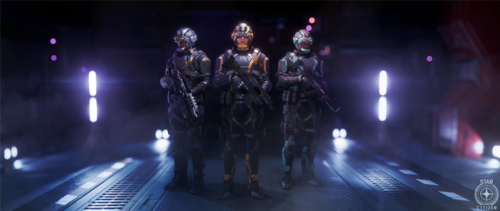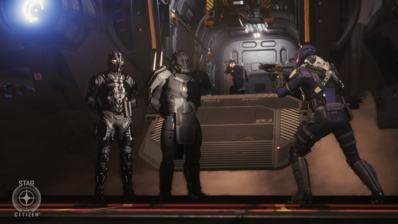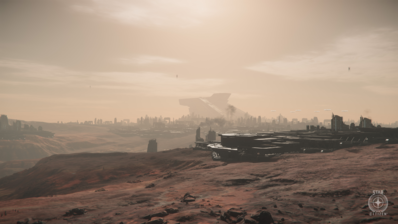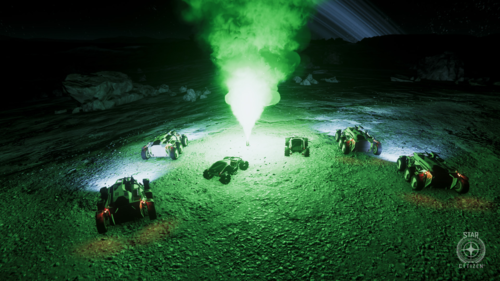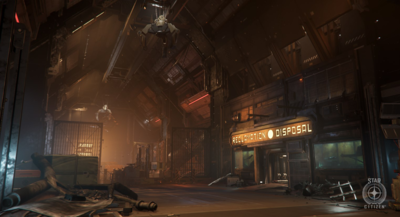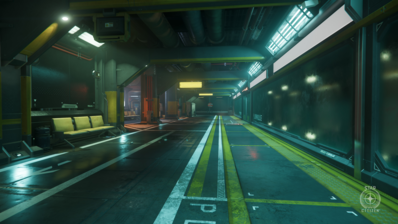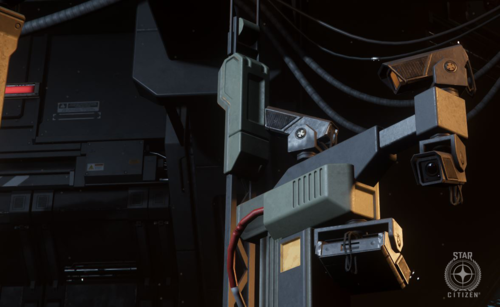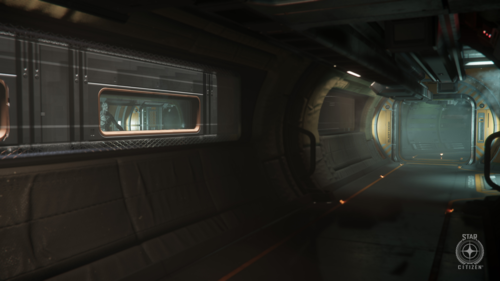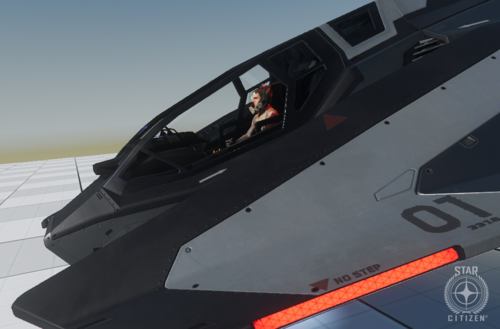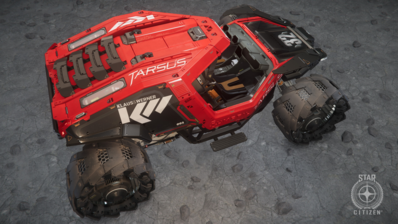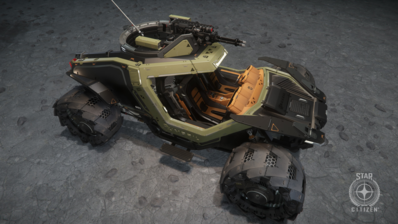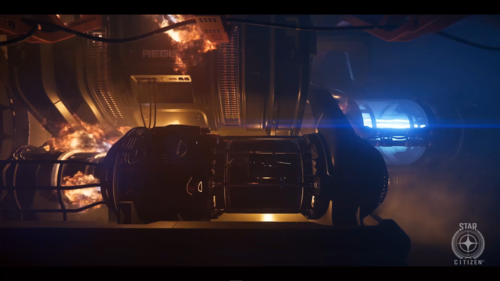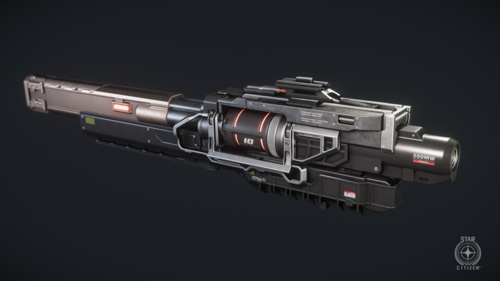Welcome to September’s monthly report from Cloud Imperium Games. This month we’re adjusting our Monthly Reports to be focused on each specific project.
This project-based approach to our monthly reports stands to provide a more detailed look at the development of both games going forward.
So, pop open a Smoltz and settle in for all the details on Star Citizen from around the Cloud Imperium empire.
For all you fans of the 2nd Fleet, a dedicated Squadron 42 Monthly Report will be released separately in the very near future.
Star Citizen Monthly Report: September 2018

AI
The majority of the AI Team’s focus this month has been on the Alpha 3.3 release. They’ve been working on multithreading the execution of the Tactical Point System, which allows a large number of environmental queries to be processed simultaneously. To achieve this, they focused on making several subsystems safe, such as the Usable Query System, Navigation, and Cover System. The result will give a big boost towards full multithreading of the Subsumption Component execution.
For human combat, they implemented several strategies used during combat activities and completed tasks to remove existing glitches and visual bugs.
They’re making progress on the Usable Builder tool, with the aim to give the designers proper visual feedback when creating objects so that they can immediately see issues or problems. Being able to preview a usable and adjust the position of its use slots, alignment slots, and all the elements associated with it will vastly speed up production.
In addition, they worked on caching entry/exit animations of the usables and the related animations to speed up runtime calls.
For the mission system, they introduced new functionalities, first of which is the ability to provide restrictions on the availability of a mission based on location. They also introduced UI binding variables that easily connect data provided by the mission logic to the user interface so that data can be easily displayed on screen.
They’re currently working on a first pass to simulate incoming and outgoing city traffic so that large cities feel more alive.
They’re currently working on a first pass to simulate incoming and outgoing city traffic so that large cities feel more alive.
Animation
The Animation Team has been working on refining the first-person experience, including tweaking weapon movement and recoil values. Work continues on ship sequencing, with the aim of increasing animation asset efficiency, while player actions were added to the bar stool to enable drinking from both standing and seating positions.
The Facial Team developed animations for the bartender and bar patrons off the back of a PCAP shoot. They also partnered with Tech Animation to test a new facial rig and ran the first set of reviews for the Facial Animation Quality benchmark. The goal here is to establish a gold-standard of facial performance on all characters throughout the Persistent Universe.
They also cleaned up the player locomotion sets and fixed bugs in preparation for the Alpha 3.3 release. The team is showing off motion capture at CitizenCon, so have been running tests to ensure everything runs smoothly.
Audio
Audio continued to support Alpha 3.3. They’ve also been prototyping new systems to allow the audio experience to scale as the project expands, with the intention to maintain the established quality bar and ensure a constantly immersive experience.
Backend Services
Backend Services has been looking into adding the S3 service, which is used to store and retrieve larger static datasets for various parts of the game.
They also finished up the NoSQL database API (which gives more fluid datasets) and finished the new Entitlement Processor to greatly optimise the processing of platform-purchased items.
As needed, they provided live support for Alpha 3.3 gameplay features to ensure everything is working as it should.
Build Engineering
A while ago, groups were formed to work on parallel branches for 3.3, with variable and control branches set up to investigate the benefits of streaming object container tech for Alpha 3.3 – this work was a success and is now complete.
Validation checks for the animation pipeline have been cemented to ensure assets intended for building and releasing align with internal file-content references. Logic is now in place to identify 3D vector field textures from regular compiled DDS textures. These 3D textures are now being welcomed into our existing asset pipeline. The releasing process received an upgrade, with additional checks put in place to help keep an overview of the final released files for Alpha 3.3.
Character Art
After completing the Odyssey Flightsuit, Virgil TruDef Pro Armor, and Hurston Collection, the team will move onto bug fixing and polishing. This content comes with material variants designed to give Hurston a varied and realistic setting.
Community
The Community Team has already hosted more contests this year than ever before, with September’s MISC Prospector commercial contest spawning some unbelievable videos.
Also this month, Bounty Hunters rallied across the ‘verse to take down criminal scum and shared their victories in a screenshot contest on Twitter. Within 24 hours, the team had received over 500 entries, showcasing that the hunt was most definitely on. More fun contests are just around the corner, so keep an eye on Spectrum for more chances to win.
A community-organized convention, Con42, took place in Germany this month, with a strong attendance from both backers and developers alike. The event included informative panels, a treasure hunt to keep people on their feet, and stories from across the ‘verse.
France’s own fan convention, Pari’Verse, is coming up on the 12th and 13th of October. So, if you’re in the area and looking to connect with other Citizens, make sure you check it out. You can find more info and get tickets on the official Pari’Verse website.
France’s own fan convention, Pari’Verse, is coming up on the 12th and 13th of October. So, if you’re in the area and looking to connect with other Citizens, make sure you check it out. You can find more info and get tickets on the official Pari’Verse website.
“We can’t wait to celebrate CitizenCon 2948 with you on October 10th. It promises to be a full day of revelry, discourse, and fun. This event has always been about celebrating the current and future developments in Star Citizen, but at the same time also honouring the incredible community that continues to evolve around the game. We’ll see you in Austin!”
This year, Star Citizen orgs had the opportunity to apply for a booth at the event, where they can celebrate their own unique history and recruit the next generation of aces to join their ranks. Furthermore, CitizenCon ticketholders had the chance to create a unique in-game emote by recording themselves and submitting their best ideas. The four winners will direct a live motion capture shoot in front of an audience at the event.
The team also updated the CitizenCon website with the latest details, including a breakdown of what to expect throughout the day.
Design
Design added new behaviors to give NPCs and Mission Givers an extra layer of ability and are currently retroactively applying them to Miles Eckhart and Ruto. They have also been diligently working towards getting Recco Battaglia and Clovus Darneely fleshed out and fully-functional for the upcoming release.
Tuning for the Economy continues, with new minable resources and updated inventories at the new outpost and truck stop locations.
The home stretch is in sight for believable bartenders and patrons in the PU, with work being done to ensure they both offer an experience that you might have at your own local establishment. They’re currently polishing their everyday behaviors, including cleaning glasses, carrying drinks to tables, and telling the player they’re busy when in the middle of an action.
Finally, the team had a clean-up and bug-fixing push to ensure that, when the players get their hand on the next build, it’s as bug-free as it can be.
DevOps
This year, the team has been able to accomplish much more internally due to recent tool and process improvements. The build system has been running 24 hours a day, churning out more independent build branches than ever before. At the same time, they’re now able to publish and maintain several times more branch targets than before. They also added a few more engineers, which has paid dividends across the board.
“We’re super excited to see the results of all our efforts throughout summer pay off as we close in on the last steps for CitizenCon and the game publishing cycle.”
Engine
This month’s focus was on the upcoming Alpha 3.3 release along with the ubiquitous Object Container Streaming. Several improvements and bug fixes were made to water volumes so they can be used in ships and on planets as designed. They continued progress on improving planetary terrain soft shadows – a lot of optimizations and tweaks went in to get a natural look at a minimal runtime cost, though additional work is still needed on blending shadow cascades. They continued progress on the physics queue (to move physics from dedicated threads to a job model) and made progress on new soft-body simulation and cloth rendering, adding support for explosions and bullet impact. In addition, they worked on numerous bugs and optimizations tasks.
Engineering
The Gameplay Team has been working on Asteroid Mining along with implementing Render-to-Texture (RTT) support for in-game shop item previews. On the tech front, the team worked on the new Transit System, which provides easier setup for elevators and supports trains that travel to schedule around larger planetary locations.
Work also continued on ongoing dynamic elements, such as ropes and soft-body simulation. The Core Engine and Network Teams focused on Object Container Streaming.
They also improved the Group System to support multiple chat groups, a feature that paves the way for Spectrum integration along with VoIP and FoIP. They also continued their efforts on scanning/ping gameplay and added support for scan/ping detection of minable rocks inside asteroid fields and other detectable entities, such as derelict ships.
Quantum Travel was improved to include routing in the Star Map. This will allow players to simply select their final destination and have the QT route plotted for them. The vehicle specialists continued to improve turret gameplay as well as support the new ships releasing this quarter.
Engine Tools
The Engine Tools Team worked on general usability improvements and game editor stability with a strong focus on supporting the needs of Alpha 3.3. The team also grew by two Tool Programmers; they’ll focus on improved tool development for Subsumption and internal profiling to gather and analyse global telemetry data. This will make it easier to enhance the general workflows for improving the overall game performance.
Environment Art
The Environment Art Team has been finalizing all the new locations going into Alpha 3.3, including graphics, navigational signs, final prop placements, dressing, optimizations, and bug fixing.
The Organics Team made the final polish on the surface of Hurston and its biomes, which will be the first-time players are able to explore lush vegetation covered biomes. With work on the planet wrapped up, they’re now supporting the Locations Team on closing out Lorville and its surrounding areas. Other than polishing and tweaking the existing areas, work involved making final art for Hurston Central, finalizing artwork on the Transit System and transit routes through the city, as well as creating and embedding the outer city gates into the planet.
Next up is the closing down of any remaining art tasks, then focus can move on to stabilisation and performance optimisations.
Gameplay Features
Gameplay Features coordinated with Backend Services to improve the Comms Chat App while in mobiGlas, and in the Visor when mobiGlas has been put away. This includes the ability to create multiple groups and invite players to join them.
“You will be able to chat with fellow players no matter how far away everyone is from each other.”
Voice Over IP is actively being developed to allow you to communicate with any group members using your own voice. Face Over IP is also in the works, allowing you to see the real-time expressions of those around you, adding nuance and emotion to your conversations.
Graphics
The Graphics Team has been working to make light and particles support multi-threading to enable them to load in the background for Object Container Streaming. It’s almost complete and will remove a stall that testers are currently seeing when they load a new location. When it’s live, players will enjoy seamlessly transition around the whole PU.
The glass shader has also been updated so that interior ship canopies no longer show distracting reflections from the exterior which, in reality, wouldn’t be visible due to the shadowing of the cockpit geometry. As usual before a major release, there have also been a number of visual issues in the new environments that have been investigated and fixed.
Issue Council
The ‘Issue Council v1.1.0’ was deployed to PTU at the start of the month before reaching Live a few weeks later. This version features a new profile section where users can see their own reports, contributions, specs, and bookmarks. Reports now feature Technical Repro and Workaround fields.
The new version received a positive response from backers.
Level Design
While expanding the Stanton system from one to two planets, the question of where to place rest stops to best support refueling came up. After some research, it was decided they would be placed at Lagrange points – naturally occurring pockets of space where two gravitational fields overlap and balance each other out. They’re the ideal place for rest stops, as they allow spacecraft to remain static without the need for additional force.
A couple of new missions have been created that take place in Security Post Kareah: Crusader Security wants the abandoned station cleared of outlaws, and occasionally criminals will want the leaders of competing factions assassinated. Kareah itself has had some big improvements to its layout, with the opening up of new routes and more cover to make firefights in the station more enjoyable.
As well as creating the Scramble Race logic, the team spent time improving the foundations of driving on planets, including headlight brightness, vehicle durability, handling, and obstacle collision. Several new asteroid clusters were added around Grim HEX in which the races and other missions can occur.
As well as creating the Scramble Race logic, the team spent time improving the foundations of driving on planets, including headlight brightness, vehicle durability, handling, and obstacle collision. Several new asteroid clusters were added around Grim HEX in which the races and other missions can occur.
A large portion of the month has been spent on Lorville and its surroundings. The team is currently adding trains and trams, setting up schedules, configuring hangars and garages, and adjusting level markups. They’re also working on the signage and general player-guiding throughout the playable areas of the city to make sure the various Points of Interest are easy to find and that visitors don’t get too lost. Progress on the Transit System is substantial and they have the first version of the system in place, allowing the team to efficiently set up elevators as well as adding in trains and trams that run to schedule.
“All of this will help bring the cities to life, even though you might have to run a bit to catch the train or accept waiting for the next one!”
They’ve started looking ahead to the upcoming areas of Stanton – ArcCorp, microTech, and Crusader. However, there’s a large amount of planning and prework that needs to be done before the teams can move onto them full time.
Lighting
The Lighting Team focused on finalizing content for the upcoming Alpha release. This involved lighting many of the locations in and around Lorville, such as the bar, admin office, and stores. In addition, they’ve also been starting optimization work across all Lorville locations to ensure better framerates while maintaining a high visual quality.
Player Relations
“The Player Relations team is busy preparing for the epic CitizenCon week in Austin, Texas!
In addition to all of the planning and work that goes into running an event in your own city, we’ve been hustling away with the Evocati to test both the ‘No OCS’ and ‘OCS’ branches. Thank you Avocados!
We’d like to point all players to our growing Knowledge Base which now has over 100 articles and seen almost 150,000 visitors since its inception. We will continue to grow this by adding new ‘How To’ articles, patch notes, and live service notifications there as well as on Spectrum.”
Props
Work continued on the utilitarian props for the Lorville landing zone, including infrastructure, furniture used to dress the main routes through the city, and smaller-scale dressing items for shops and bars. A polish pass on some older dressing assets was completed, with visual modelling improvements made to the meshes. Older assets using outdated glass shaders were also converted over to the new version to improve both the performance and visual quality.
The team delivered a set of animated signage, cameras, and interactive dressing props to add life and movement to the city. Finally, the team began work on a new mission set prop that will be going live soon.
QA
The QA Team heavily focused on testing Alpha 3.3. The EU and ATX QA teams have been working closely to run various playthroughs and smoke-test builds for specific features. Alongside this, they worked on various QA Test Requests, one of which will bring significant changes to how the upcoming AI performs in-game. The AI change to Tactical Point System Query (TPSQuery) will allow for increased control over the number of queries that can be executed at the same time. This should reduce the amount of AI characters a player sees standing around doing nothing. They also made a test request for new physics changes that will reduce issues, such as physics collision detection buffers overflowing due to too many objects overlapping, objects getting pulled into random interior grids, objects missing, objects appearing with initial damage, etc. These changes also affect the new transit system.
Testers have been working with the Level Design and Gameplay teams to ensure that the new elevator system and metro rail are functioning properly, as well as setting up test levels to be used by Physics Engineering to investigate any new issues that may arise. They also increased support for the AI Actor Feature Team to now include testers across all studios as opposed to only having support from the UK.
Part of the team was busy testing upcoming features like Asteroid Mining and Rest Stops, new vehicles like the Mustang revamp and Cyclone variants, as well as preparing for CitizenCon.
On the Leadership side, it was business as usual as they coordinated testing priorities for all the new builds. They also continued updating the TestRail software as new features came online along with adding some new QA testers to the team.
Ships
The bulk of artwork done this month has been towards supporting Alpha 3.3. Outside of that, the team made strides with the glass shader, fixed bugs in preparation for Alpha 3.3, and finalised the Aegis Hammerhead.
On the design side, support was given in the global push towards Alpha 3.3 along with the groundwork for ships in Alpha 3.4 and beyond. They also spent a fair amount of time working on item balance and reacting to the internal and external feedback on the cannon changes that have just hit Evocati.
Ship Art
The Ship Art Team had to pause for a couple weeks on the 300 series updates to take care of some pilot-fitting issues on a prominent Squadron 42 campaign ship. Now that it’s done, they’re back in full swing on the 300i grey-box.
They also recently completed the long-awaited Constellation Phoenix, finishing the last few LOD tasks, and polished the conference table and piano (not literally). Once the final Phoenix bugs are worked out, they’ll move onto the Banu Defender:
“We’re very excited about this and are already doing the preliminary work to ensure the visuals match everyone’s expectations.”
System Design
The System Design Team was primarily occupied with tasks for the 3.3 release. They made progress on FPS combat AI, with improvements to perception and reaction to stimuli. Cover selection was modified to enable enemies and allies to more intelligently choose when and where to seek cover. They now also give increased vocal feedback, so players understand more clearly what they are thinking and what is happening during encounters. The next step will be to get the same functionality working in multiplayer.
The gameplay features for asteroid mining are complete, with the team now moving on to bug fixing, polishing, crunching numbers, testing, and generally making sure players will have an enjoyable experience.
“Expect new minable elements, more searching through the rubble for golden nuggets, and more time spent using your radar finding the right rocks.”
They also completed work for an upcoming release, with the focus on getting NPC ships to properly take-off, land, and quantum travel so that the universe can be populated with traveling NPCs.
Tech Animation
Tech Animation continued their work on the weapon batch exporter, which will enable the animators to iterate faster over their weapon animations. They also fixed various bugs in the animation tools set and added some new functionality with the goal of improving the way animators work.
Tech Art
The Tech Art Team continued work on the next-gen character cloth and softbody authoring pipeline and toolset. The data interchange format between Maya and the engine has been re-factored to enable various additional global and local ‘per-vertex’ dynamic attributes to be authored, transferred, and stored efficiently. These attributes enable complex dynamic effects such as friction, air lift, drag, and collision softness. They also allow fine-grained control over the various cloth-internal properties such as stretch, compression, and bend stiffness (and even volume preservation in the case of volumetric softbodies) on a per-asset basis as needed. They also added the ability to author so-called collision proxies together with the character animation rigs and meshes in Maya. Since full-on polygon mesh-based collision detection and resolution is still fairly costly to achieve in realtime, simple geometric primitives such as spheres, boxes, ellipsoids, or capsules are used to approximate the objects that cloth and other softbodies are supposed to collide with. For example, in order to let a skirt collide with the (approximated) legs of a character.
Turbulent
Turbulent has been hard at work this month providing support on all fronts in preparation for CitizenCon! Spectrum is now on release v.8.2 this month, with several bug fixes made, including the addition of emojis.
Quill, the new Spectrum editor, is in the QA stage of development. It’s set to replace the old editor and will resolve various bugs linked to Android. Due to the development work for Alpha 3.3, Spectrum progress will be picked up again the following month.
CitizenCon Merchandise is here! Ticket holders can purchase t-shirts and wireless chargers in advance to be picked up at the event. Backers who have purchased a Digital Goodie Pack can purchase t-shirts to be shipped to their address. Turbulent supported the release of the event merchandise on the platform side.
CitizenCon Merchandise is here! Ticket holders can purchase t-shirts and wireless chargers in advance to be picked up at the event. Backers who have purchased a Digital Goodie Pack can purchase t-shirts to be shipped to their address. Turbulent supported the release of the event merchandise on the platform side.
Turbulent undertook the badge printing for CitizenCon, which will display a QR code unique to each ticket holder’s account as well as details such as their name, avatar, and main org. The QR code is linked to our ticket-scanning app made for the event.
After the CitizenCon microsite update last month, the team has been working on building out the Livestream pages. While watching the event, you’ll be able to chat live with other Citizens.
After the CitizenCon microsite update last month, the team has been working on building out the Livestream pages. While watching the event, you’ll be able to chat live with other Citizens.
Turbulent also helped with this month’s Pirate Promotion, which included sales of the Aegis Gladius, Aegis Sabre, Aegis Hammerhead, Anvil Super Hornet, and Freelancer MIS.
UI
This month, UI supported the Mission Team by creating a persistent objectives widget on the HUD and crafted the pickup and delivery interactive displays utilizing the new UI authoring tool (which is still in early development). They began building the branding, identity, and fictional advertisements for truck stops and landing locations in the PU.
Vehicle Features
The Vehicle Features Team improved the manned turret experience by:
- Adding an interface to turn gyro-stabilization on/off.
- Finalizing the 1:1 input-to-rotation techniques for mouse and joystick, including properly adjusted input options for both.
- Adding head look smoothing for a less jarring view from within turrets.
- Programming automated turrets to now use the criminality system to determine whether or not to fire upon you.
Scanning vehicles was also extended to include stats such as vehicle status, owner, pilot, and onboard cargo.
Discovering entities on planets, asteroids, and deep space has been improved by allowing for much greater ping results, more informative blob aesthetics, and separate blob generation based on whether entities are on a planet’s surface or in deep space. Finally, the technique in which mineable rocks are spawned on asteroids and planetary bodies has been made more efficient.
Discovering entities on planets, asteroids, and deep space has been improved by allowing for much greater ping results, more informative blob aesthetics, and separate blob generation based on whether entities are on a planet’s surface or in deep space. Finally, the technique in which mineable rocks are spawned on asteroids and planetary bodies has been made more efficient.
Vehicle Content
The Star Citizen Alpha 3.3 release was the primary focus for the Vehicle Content Team throughout September. Tech Art completed their release prep passes on all of the vehicles going out in the update: the Aegis Hammerhead, RSI Constellation Phoenix, Tumbril Cyclone variants, and the rework of the Consolidated Outland Mustang. Both the Art and System Design teams completed their release prep passes on the Mustangs and Cyclones, while Systems Design also completed their pass on the Phoenix. All teams have been working on polish tasks and bug fixing to get these vehicles into great shape for the backers.
Additionally, the teams were involved in an ongoing process of creating sequenced animations for vehicles, in particular the Cyclone TR and Mustang Beta.
The Art and Systems Design teams also continued to move forward on the Anvil Hawk, which is whitebox complete on the design-side and into the final art stage.
The Art and Systems Design teams also continued to move forward on the Anvil Hawk, which is whitebox complete on the design-side and into the final art stage.
VFX
VFX worked on several new biomes surrounding Lorville that are continually being iterated on, which will be included in an upcoming patch. They also continued to fine-tune the multitude of effects seen in and around Lorville, with a particular focus on optimisation. They also finalised VFX for several new vehicles, including the mighty Hammerhead’s interior and exterior damage, and exhaust misfires for the Tumbril Cyclone.
Weapons
The Weapon Art Team finished production on the new Hurston Dynamics ship weapons.
Web Platform
This month, work focused on supporting the new features that gravitate around the Groups System. The new version is the primary component responsible for orchestrating chat lobbies and voice channels. A new group type made its entry in the system for supporting Instance and Server groups. The team also spent time fixing a few bugs related to the timing of incoming events and improving observability of the service by adding stats and reporters.
A new service called the Group Coordinator entered the network this month. This is in charge of tracking dedicated game servers entering/exiting the pool and creating the proper group resources needed to power a server-wide group, lobby, and voice channel. This service is isolated but uses the current network resources to achieve this automation while still notifying game clients about the changes, which then get replicated to the mobiGlas.
The lobby service work this month focused mainly on hardening and dealing with a few edge cases related to how events are processed. A few major bugs were fixed on how the player identifiers are carried across messages and observability improvements were made to Quality of Service.
Voice service work was completed this month allowing the sharing of voice channels across a fleet of voice servers as well as improving the scalability and reliability of how channels are created. Voice streams carried over the network are now properly attached to the player entities in the game space. Proper audio treatment gets added as players connect and disconnect from channels via the mobiGlas. Additional work was done to address issues identified in face-sync. Observability improvements were made for Quality of Service.
Major infrastructure work was advanced this month in how we store and process the Domain Events submitted to the Event Bus. A new set of clustered resources are now used and the orchestration of our game services containers got a big upgrade by moving to a Kubernetes based orchestrator. This gives Turbulent the ability to scale and easily orchestrate the game service resources. This is the first step in this new direction which we hope will allow for faster deployments and more reliable services all around.
Conclusion
WE’LL SEE YOU NEXT MONTH…
$(function() { Page.init();
window.Page = new RSI.Game.About(); });
Source: https://robertsspaceindustries.com/comm-link/transmission/16790-Star-Citizen-Monthly-Report-September-2018

